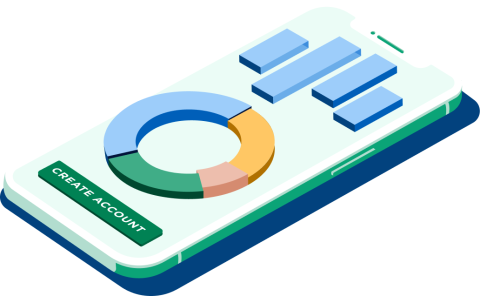High-Yield Bonds: What You Need to Know

Many or all of the products featured here are from our partners who compensate us. This influences which products we write about and where and how the product appears on a page. However, this does not influence our evaluations. Our opinions are our own. Here is a list of our partners and here's how we make money.
The investing information provided on this page is for educational purposes only. NerdWallet, Inc. does not offer advisory or brokerage services, nor does it recommend or advise investors to buy or sell particular stocks, securities or other investments.
High-yield bond definition
High-yield corporate bonds — also called “junk bonds” or “non-investment grade bonds” — are debt obligations issued by companies looking to raise capital, and they generally offer higher interest rates than investment-grade corporate or government bonds because their risk factor may also be higher
As with any bond arrangement — investors effectively lend money to the firm issuing the bond, in exchange for regular interest payments over a set term — the scheduled interest payments and return of principal are not guaranteed. If the company suffers losses due to adverse economic conditions, there is a risk the company may default and not be able to make its payments on time. And high-yield bonds have a higher risk of default, which is why they offer the lure of higher interest rates.
» Learn about stocks vs. bonds

via Zoe Financial
Understanding high-yield bonds
There are many ways bonds can be structured in the high-yield space, but they all share two main characteristics:
Coupon rate: the annual interest rate promised by the issuer to the bondholder.
Maturity: the date when the term of the bond ends and the original principal payment is due to be paid back to the bondholder.
And most high-yield bonds are issued in blocks with a face or par value of $1,000 with a term to maturity of seven to 10 years.
Some bonds may have floating interest rates, meaning the rate is subject to change based on market conditions according to the terms of the bond. There are also “zero-coupon” bonds, which are offered at a steep discount relative to their par value. Zero-coupon bonds do not make annual payments to the bondholder, but investors benefit when they receive the face value of the bond at maturity. High-yield bonds may also have call provisions, which allow the issuer to buy the bond back from investors if it is deemed beneficial to the issuer due to fluctuating interest rates in the bond market.
» MORE: Learn about corporate bonds and how they're structured
High-yield bonds and credit ratings
When corporations issue a bond, they must undergo a rating from a credit agency like Moody’s, Standard & Poor’s or Fitch. These agencies review each company’s finances to determine their creditworthiness and assign a rating. Companies in good financial standing typically get an “investment grade” rating from these agencies. Investment-grade corporate bonds generally carry lower risk due to an established history of meeting their debt obligations on time.
Investment-grade bond ratings | |||
Moody's | Standard & Poor's | Fitch | What the grade means |
Aaa. | AAA. | AAA. | Highest quality, minimal risk. |
Aa. | AA. | AA. | High quality, very low risk. |
A. | A. | A. | High/Medium quality, low credit risk. |
Baa. | BBB. | BBB. | Medium grade, moderate credit risk. |
Non-investment-grade bond ratings | |||
Moody's | Standard & Poor's | Fitch | What the grade means |
Ba. | BB. | BB. | Substantial credit risk. |
B. | B. | B. | High credit risk. |
Caa. | CCC. | CCC. | Low quality, very high credit risk. |
Ca. | CC. | CC. | In or near default, some prospect of recovery. |
C. | C. | C. | Moody's lowest rating, typically in default with little prospect of recovery. |
C. | D. | D. | In default, also used when bankruptcy has been filed. |
New companies without an established history and companies in poor financial standing typically receive a “non-investment grade” rating. To compensate for the higher risk involved, these bond issuers will raise the amount of interest they are willing to pay to make their bond offering more appealing and entice investors. Generally, the greater the amount of risk involved with the company issuing the bond, the higher the yield.
So how much more interest can you make by investing in high-yield bonds as opposed to investment-grade bonds? Is it worth the risk? Unfortunately, these questions are difficult to answer without looking at each bond on a case-by-case basis. Bond interest rates are constantly changing, so investors must carefully weigh the risk and reward of each individual bond purchase. Remember, since high-yield bonds come with additional risk, there's a greater chance that the issuer may not be able to pay interest to their bondholders on time.
» Feeling sustainable? Learn about green bonds
Who issues high-yield bonds?
Firms that issue bonds may do so because they are looking to raise capital for growth, expansion, debt restructuring or other cash-flow needs to operate the business. Bonds available for purchase can be found across many (if not all) business sectors, but companies that issue high-yield bonds generally share one common characteristic — a high debt load relative to business income and cash flow.
A high debt load on a company’s balance sheet usually results in receiving a non-investment grade rating from credit agencies, but there are a few different reasons a company might carry a large amount of debt:
Fallen angels are companies that maintained an investment-grade rating at one point in time, but have been downgraded to non-investment-grade by the credit agencies. Fallen angels are usually companies that have experienced difficulty meeting their debt obligations due to adverse economic conditions in their sector, and many of them issue high-yield bonds in an attempt to improve their balance sheet to reestablish their investment-grade rating. It is not uncommon for fallen angels to carry an investment-grade rating from one credit agency, and a non-investment-grade rating from another. Bonds with varying credit ratings are often referred to as split-rated or crossover.
Startup companies may receive a poor credit rating because they do not have an established history of meeting their debt obligations in a timely manner. Many new companies take on more debt as they need capital to grow.
Companies that have declared bankruptcy may offer high-yield bonds in order to raise capital to finance a bankruptcy exit.
Buyouts occur when one company acquires another. Corporations often use a large amount of borrowed money to finance an acquisition, and these transactions are referred to as a leveraged buyout. In an LBO, the large amount of debt undertaken by the purchasing company will impact their balance sheet and credit rating. Thus, many high-yield bonds can be found in the LBO space.
» Learn more: Bonds vs. CDs

Advantages and disadvantages of high-yield bonds
The biggest advantage of investing in high-yield bonds is that they have higher interest rates than their investment-grade corporate and government counterparts. In a low-interest-rate environment, investors looking for better return on fixed-income investments might be tempted to seek out high-yield bonds in order to stay ahead of inflation and maintain purchasing power.
However, high-yield bonds carry additional risk, so investors must carefully weigh how much risk they’re willing to take on in order to achieve better returns. High-yield bonds carry all of the same risks as investment-grade bonds, but the likelihood of each risk factor presenting itself is much higher for these non-investment grade bonds.
One way to try to mitigate these risks is by investing in a high-yield exchange-traded or mutual fund. This way, you can spread risk across multiple companies and market sectors as opposed to relying on one company to meet its debt obligations. Another benefit of purchasing an ETF or mutual fund in the high-yield space is that it is far less costly. Buying individual high-yield bonds in blocks of $1,000 per bond is expensive, and it becomes difficult to achieve the same level of diversification that a high-yield bond fund can offer.
As always, if you’re unsure whether investing in high-yield bonds is the best choice for your portfolio, speaking with your financial advisor can help guide your decision. If you’re interested in getting started, make sure you’ve done your due diligence and that you understand the terms and conditions of any bond or fund before investing.
» MORE: Read about how to buy bonds
NerdWallet rating 4.9 /5 | NerdWallet rating 5.0 /5 | NerdWallet rating 4.1 /5 |
Fees $0 per online equity trade | Fees $0 per trade | Fees $0 per trade |
Account minimum $0 | Account minimum $0 | Account minimum $0 |
Promotion None no promotion available at this time | Promotion None no promotion available at this time | Promotion Get up to $700 when you open and fund a J.P. Morgan Self-Directed Investing account with qualifying new money. |
Are high-yield bonds a good investment?
As with any investment, whether or not high-yield bonds are right for you will depend on your personal risk tolerance, your investment timeline and the balance of your existing investment portfolio. Bonds are often viewed as more conservative investments, but the nature of high-yield bonds makes them a bit riskier. Considering your asset allocation can help you decide if including high-yield bonds is right for you.






